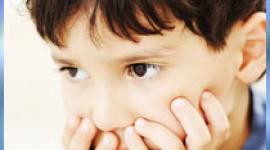Medication Effective in Treating Anxiety Disorders in Children and Adolescents
Large study shows Luvox is safe and effective in treating anxiety disorders in children and adolescents.
 A multi-site study to evaluate treatments for anxiety disorders in children and adolescents, funded by the National Institute of Mental Health (NIMH), found that a medication was more than twice as effective as the placebo, or sugar pill. The research trial, which cost $1.7 million, involved 128 children and adolescents ages 6 to 17 over a period of eight weeks. Symptoms improved in 76 percent of those randomly assigned to take the medication, compared to only 29 percent of those in the placebo group. The study, "Fluvoxamine (Luvox) For The Treatment Of Anxiety Disorders In Children And Adolescents," is being published this week in the New England Journal of Medicine.
A multi-site study to evaluate treatments for anxiety disorders in children and adolescents, funded by the National Institute of Mental Health (NIMH), found that a medication was more than twice as effective as the placebo, or sugar pill. The research trial, which cost $1.7 million, involved 128 children and adolescents ages 6 to 17 over a period of eight weeks. Symptoms improved in 76 percent of those randomly assigned to take the medication, compared to only 29 percent of those in the placebo group. The study, "Fluvoxamine (Luvox) For The Treatment Of Anxiety Disorders In Children And Adolescents," is being published this week in the New England Journal of Medicine.
Although anxiety disorders affect an estimated 13 percent of children and adolescents during any given six-month period, making them the most common class of psychiatric disorders in that age group, the disorders are often not recognized, and most who have them do not receive treatment.
Common signs of anxiety disorders in children are excessive worrying about ordinary activities, such as going to school or summer camp, taking a test or performing in sports. At times, there are physical symptoms such as palpitations, sweating, trembling, stomachache, or headache. There may be avoidance of certain situations that are perceived by the child to be sources of anxiety. This avoidance can cause social withdrawal. When these symptoms cause extreme distress and interfere with the functioning of the child in usual activities, a child is diagnosed as having an "anxiety disorder."
These disorders are properly recognized through a careful evaluation that includes direct examination of the child, a parent interview and a collection of past history. Anxiety disorders cause significant suffering and functional impairment in the affected children. While not all of them will continue to suffer from these disorders into adulthood, some will, and early treatment may help prevent future mental health problems, including suicide attempts.
Researchers used four inclusion criteria to select participants for the study, including a clinician-rated scale that was developed for the study to assess symptoms of the targeted disorders. The participants also had to go through several weeks of extended evaluation, during which time supportive psychotherapy was initiated. Only children who had not adequately improved at the end of that period were entered into the medication study. This was done to avoid exposing to medications children who might have improved with simple support and encouragement.
NIMH director Steven E. Hyman said, "This ground-breaking study is a big step forward in our understanding of how to treat children and adolescents with anxiety disorders. More research is still needed, however, to compare the efficacy of existing therapies, including cognitive-behavior therapy, to, or in combination with, medication."
The medication used in this new study, fluvoxamine, is one of the class known as selective serotonin re-uptake inhibitors (SSRIs), which is used to treat depression and anxiety disorders in adults. This medication has also been approved for treatment of obsessive-compulsive disorder in adults and children age 8 and above. Children and adolescents with a current diagnosis of obsessive-compulsive disorder were among those excluded from the study, which focused on those with at least one of three other anxiety disorders that typically occur together: generalized anxiety disorder, separation anxiety disorder, and social phobia.
"Although physicians often prescribe fluvoxamine for children and adolescents with these three anxiety disorders, this is the first rigorous examination of this medication's safety and efficacy in treating them," said Daniel Pine, one of the researchers on the study. "Each child or adolescent whose functioning is impaired by anxiety disorders should be carefully evaluated by a professional who is familiar with childhood anxiety disorders to determine the best course of therapy for that particular child." Dr. Pine is now Chief of Development and Affective Neuroscience and Child and Adolescent Research in the NIMH's Intramural Mood and Anxiety Disorders Program.
No severe side effects from the medication occurred in the study, although 49 percent of the study participants who were taking it had stomachache compared to 28 percent of the children and adolescents on placebo. The medication was also associated with greater increases in children's levels of activity than was the placebo. The side effects, however, were usually mild, and only five of the 63 children in the medication group discontinued treatment as a result of these adverse events, as compared with one of the 65 children in the placebo group. Most of the participants were under age 13. Half were boys. About 65 percent were white and about 35 percent were from minority ethnic groups.
The study was conducted at five sites of the Research Units of Pediatric Psychopharmacology (RUPP) network, which is funded by NIMH. The RUPP network is composed of research units devoted to conducting studies to test the efficacy and safety of medications commonly used by practitioners to treat children and adolescents (off-label use) but not yet adequately tested.
Source:
- NIMH, April 25, 2001
next: Anxiety in the Elderly
~ anxiety-panic library articles
~ all anxiety disorders articles
APA Reference
Staff, H.
(2001, April 26). Medication Effective in Treating Anxiety Disorders in Children and Adolescents, HealthyPlace. Retrieved
on 2025, April 20 from https://www.healthyplace.com/anxiety-panic/articles/medication-effective-in-treating-anxiety-disorders-in-children-and-adolescents



